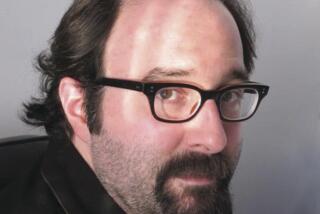Op-Ed: Can science fiction help us prepare for 21st-century warfare?
- Share via
The novelist Margaret Atwood recently caused a stir when, during an interview with Variety, she said that the 9/11 hijackers “got the idea” to fly planes into buildings from watching “Star Wars.”
Atwood, the author of “The Handmaid’s Tale” and other dystopian classics, did not have the facts right. The 19 hijackers were not inspired by “Star Wars.” Al Qaeda wasn’t reenacting the destruction of the Death Star.
But the premise of Atwood’s comment was not at all far-fetched. Literature and film have long sought to capture the realities of war, and, in turn, they have influenced thinking about war. There is a direct relationship between real war and “reel” war.
This is nothing new, of course. Art has been influencing war, and vice versa, since the beginnings of recorded human conflict. “The Iliad” is an ancient and largely made-up tale of war, yet Alexander the Great reportedly slept with a copy of the book under his pillow.
John Steinbeck never saw battle, but his 1942 novel “The Moon Is Down,” about the military occupation of a small town, became enormously influential in Europe during World War II, serving as a narrative guide for resisters to the Nazi occupation. It was so helpful to the resistance movement in Norway that Steinbeck was awarded the country’s King Haakon VII Freedom Cross for wartime achievement in 1945.
Margaret Atwood may have drawn ridicule for suggesting that the 9/11 hijackers were inspired by ‘Star Wars,’ but her proposition was far from implausible.
Contemporary warriors still learn from fiction. The retired generals Stanley McChrystal and David Petraeus have both said that they were profoundly influenced by “The Centurions,” a 1960 novel about French paratroopers in Indochina and Algeria. The former NATO supreme allied commander and retired four-star Navy admiral James Stavridis has cited the collected works of Hemingway as inspiration for his military career.
The 9/11 Commission Report noted that intelligence officials were aware that commercial airplanes could be weaponized. They had learned this not from national intelligence sources, but from a novel: Tom Clancy’s “Debt of Honor,” published in 1994, in which an airliner is flown into the Capitol building in Washington, D.C., nearly wiping out America’s political leadership.
The U.S. government typically classifies this sort of information — i.e., information with intelligence value that comes from a book, a film or some other creative endeavor — as open-source intelligence (“OSINT”), meaning that it was gleaned from publicly available material.
The government has even made ad-hoc efforts to mine fiction for intelligence purposes. After 9/11, the Pentagon asked two dozen Hollywood writers and directors to speculate about unanticipated attacks that could follow.
More recently, the Army chief of staff, Gen. Mark A. Milley, speaking at the Pritzker Military Museum and Library in Chicago in 2016, acknowledged that science fiction is “something we pay close attention to,” a tool to help the military suss out the requirements of potential conflicts.
The nature of warfare has never been more fast-changing than it is today. And as Michael Morell, a former deputy and acting director of the CIA, recently told the Atlantic, the U.S. has never faced as many threats as it does now. It may very well take Hollywood-grade creativity to anticipate and counter them.
For this reason, the U.S. should do more to leverage the longstanding informal relationship between fiction and war. Instead of inconsistent efforts and one-offs, our national security agencies should expand this sort of speculative research into more formal, ongoing programs.
The U.S. Army recently announced a major initiative, Futures Command, to help it anticipate and adapt to coming combat by harnessing the expertise of business leaders, technologists and academics. (Three cities in California — Los Angeles, San Diego and San Francisco — are on the short list of locations being considered for the Futures Command headquarters.) The Army should make room in this new initiative for strategic imagineers, including screenwriters and novelists.
Within Futures Command and across other agencies, creative experts could serve as a vital source of fiction intelligence — or “FICINT,” a term coined by the national security analyst August Cole — helping to foresee the next major attack on America, shaping preventive strategies and even deploying when necessary.
Margaret Atwood may have drawn ridicule for suggesting that the 9/11 hijackers were inspired by “Star Wars,” but her proposition was far from implausible. What’s more, Atwood was entirely correct when she made the follow-up comment that science-fiction writers are uniquely talented at “anticipating future events.”
The U.S. military would be wise to formally harness that talent. As the 9/11 Commission’s report memorably concluded, the “most important failure” leading to the September 11 attacks was “one of imagination.” Unlike with “Star Wars,” we cannot allow a sequel.
Major ML Cavanaugh is an Army officer and a fellow with the Modern War Institute at West Point. He co-edited “Strategy Strikes Back: How Star Wars Explains Modern Military Conflict.”
Follow the Opinion section on Twitter @latimesopinion or Facebook
More to Read
A cure for the common opinion
Get thought-provoking perspectives with our weekly newsletter.
You may occasionally receive promotional content from the Los Angeles Times.










